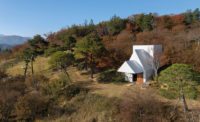Allyson Vieira builds monuments—but she uses unexpectedly humble material. Take her 2013–14 exhibition The Plural Present. There, the New York–based artist filled a gallery with Classical ruins: The City Wall, 2013, delimited the space with a colonnade that framed Beauty, Mirth, and Abundance, 2013, three figures striking a contrapposto that echoes the famed Greek statue of the three graces at the Metropolitan Museum of Art. But Vieira’s statues are made from cheap brick, crudely carved and stacked into angular abstractions. Rather than a pediment, they hold up a length of pipe. The city walls are nothing more than 20-foot metal studs—the kind you could pick up at Home Depot—torqued into an elegant shape, though it appears to be suspended in mid-collapse. “I’m into the long time line,” says Vieira, who has an exhibition at The Breeder gallery in Athens opening on August 27 (the gallery also represents Andreas Angelidakis). “I don’t want to make work about today if I can’t also make work about 1,000 years ago,” she adds. Vieira’s interest in the architecture of antiquity comes from a fascination with building, sculpture, material, and time—the churn of the making process, and a cycle of construction and collapse in which one era’s ruins become another’s raw material. Her workaday palette fixes her historical references in the present. “I’m interested in human proportions that go into building,” says Vieira, whose column figures are exactly her height. “I love that the width of a standard sheet of drywall is roughly a person’s arm span.” For a pair of 2013 works in her Weight Bearing series, the artist sawed stacks of gypsum board into jagged figures and then raised a steel I-beam onto the top of each pair. Like the threshold of a ruined temple, her works have an aura of inscrutable ritual significance, one whose meaning seems lost to time even as its shape endures. “The post-and-lintel structure is the easiest way to raise a surface,” she notes. “The forms that get me excited are the ones that have persisted.”
Allyson Vieira

2013'14 exhibition The Plural Present
Photo courtesy Daniel Perez; Swiss Institute, New York

Installation view of Allyson Vieira's 2013 exhibition, The Plural Present, at the Swiss Institute in New York.
Photo courtesy Courtesy Swiss Institute, New York / Daniel Perez

Beauty, Mirth, and Abundance, 2013.
Photo courtesy Kunsthalle Basel / Laurel Gitlen, New York

Clad (Beauty, Mirth, and Abundance III), 2013.
Photo courtesy Kunsthalle Basel / Laurel Gitlen, New York

Clad (Beauty, Mirth, and Abundance III), 2013.
Photo courtesy Kunsthalle Basel / Laurel Gitlen, New York

For a pair of 2013 works in her Weight Bearing series, the artist sawed stacks of gypsum board into jagged figures and then raised a steel I-beam onto the top of each pair.
Photo © Cathy Carver, courtesy Laurel Gitlen, New York

Installation view of Allyson Vieira's 2013 exhibition, Cort'ge, at Laurel Gitlen in New York.
Photo courtesy Cathy Carver; Laurel Gitlen, New York


Post a comment to this article
Report Abusive Comment